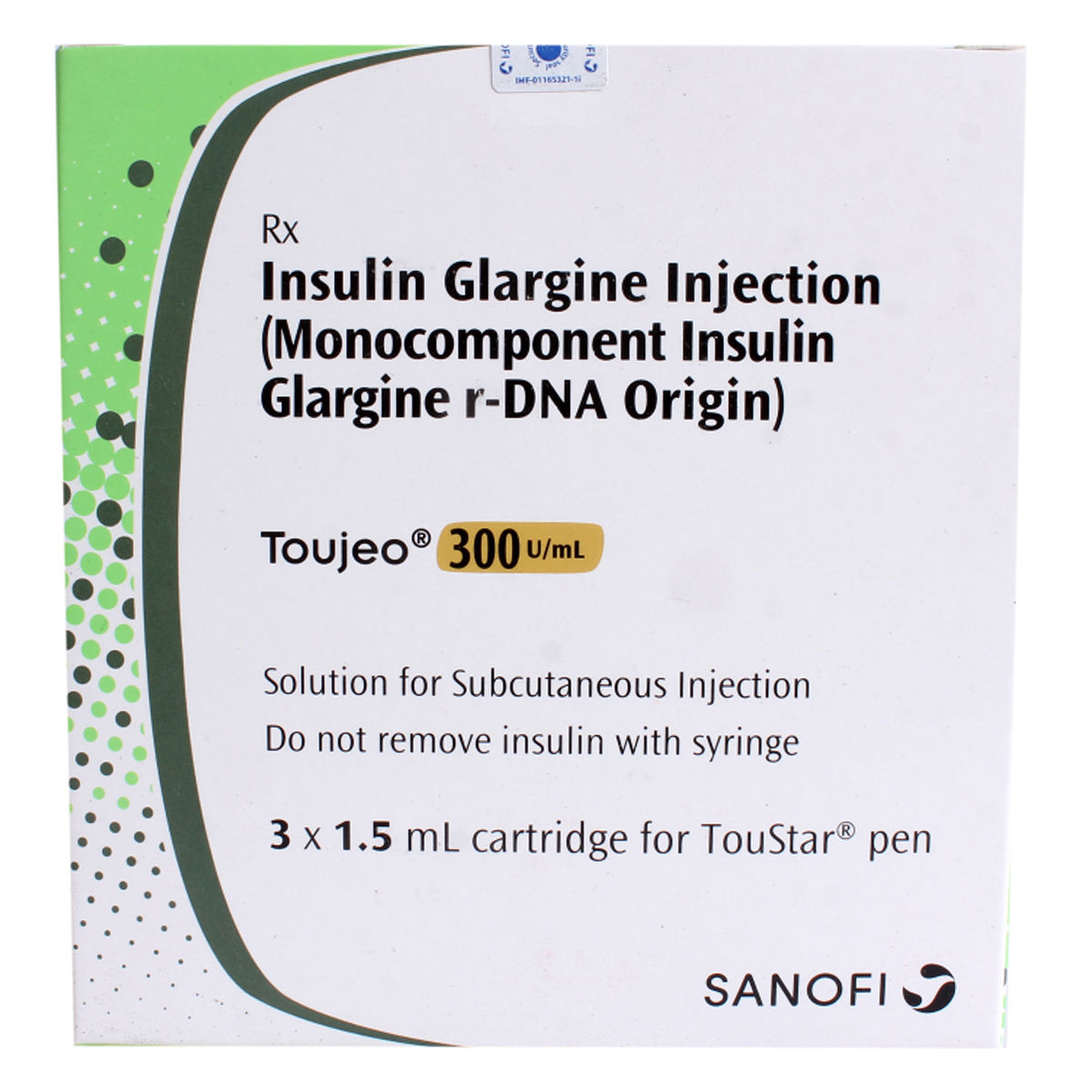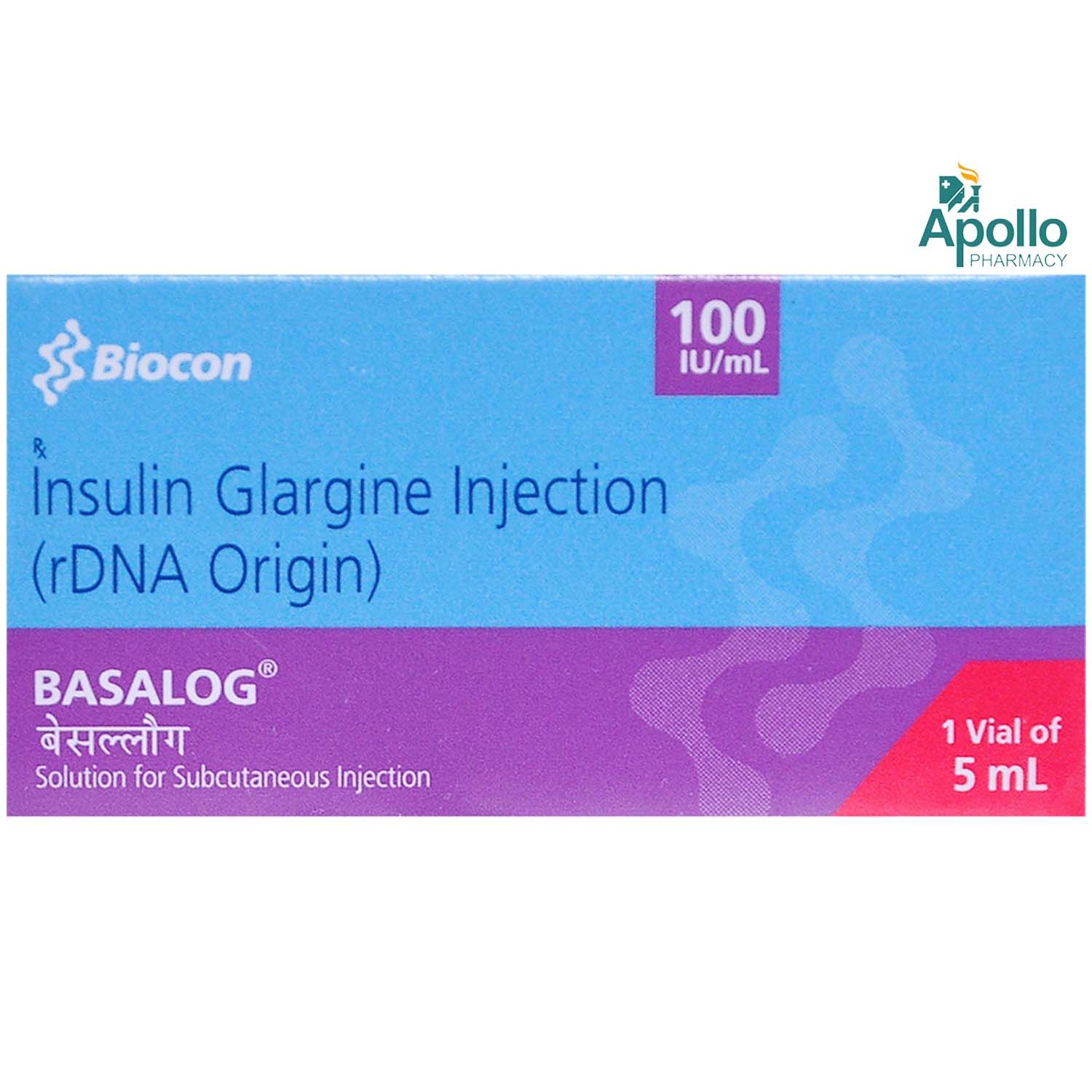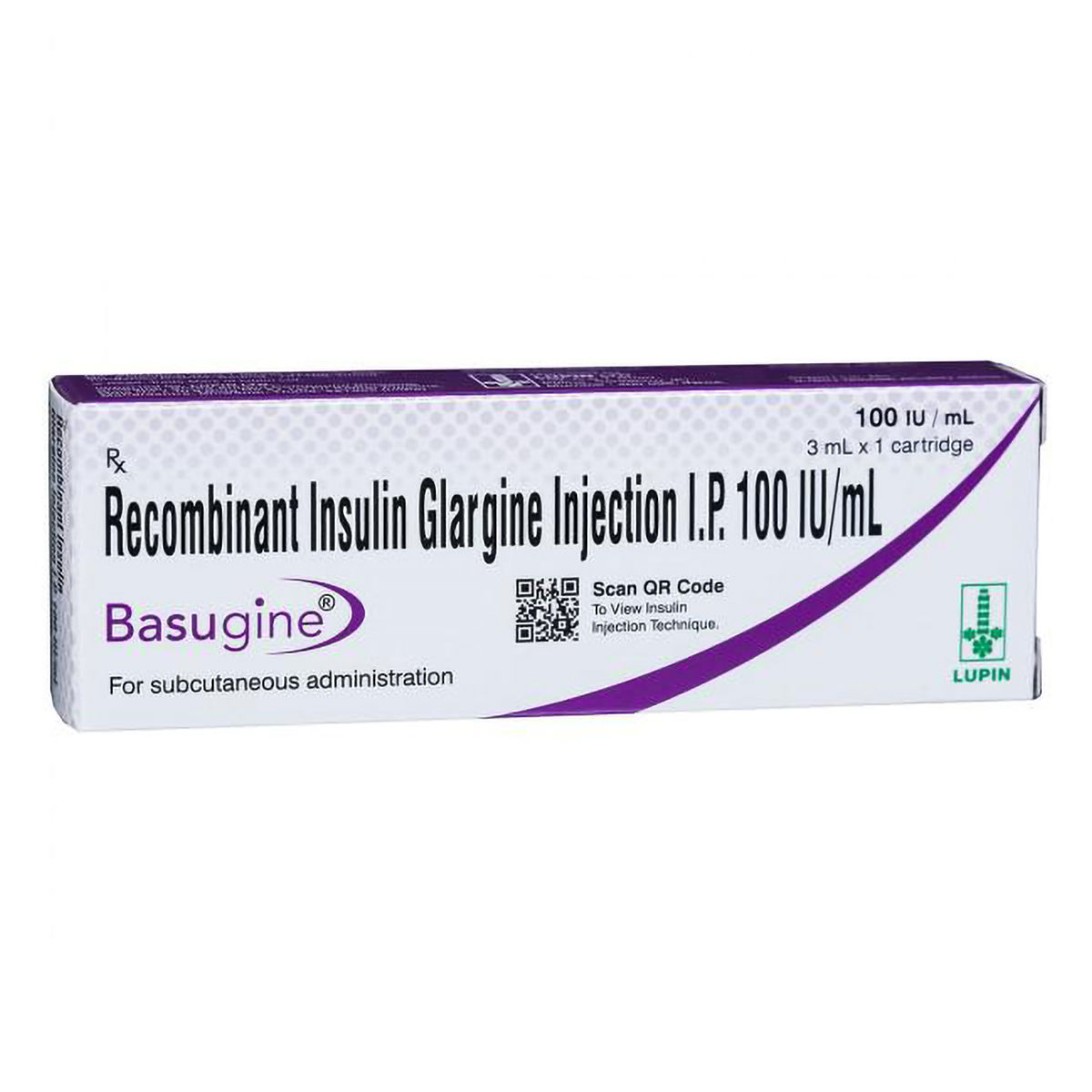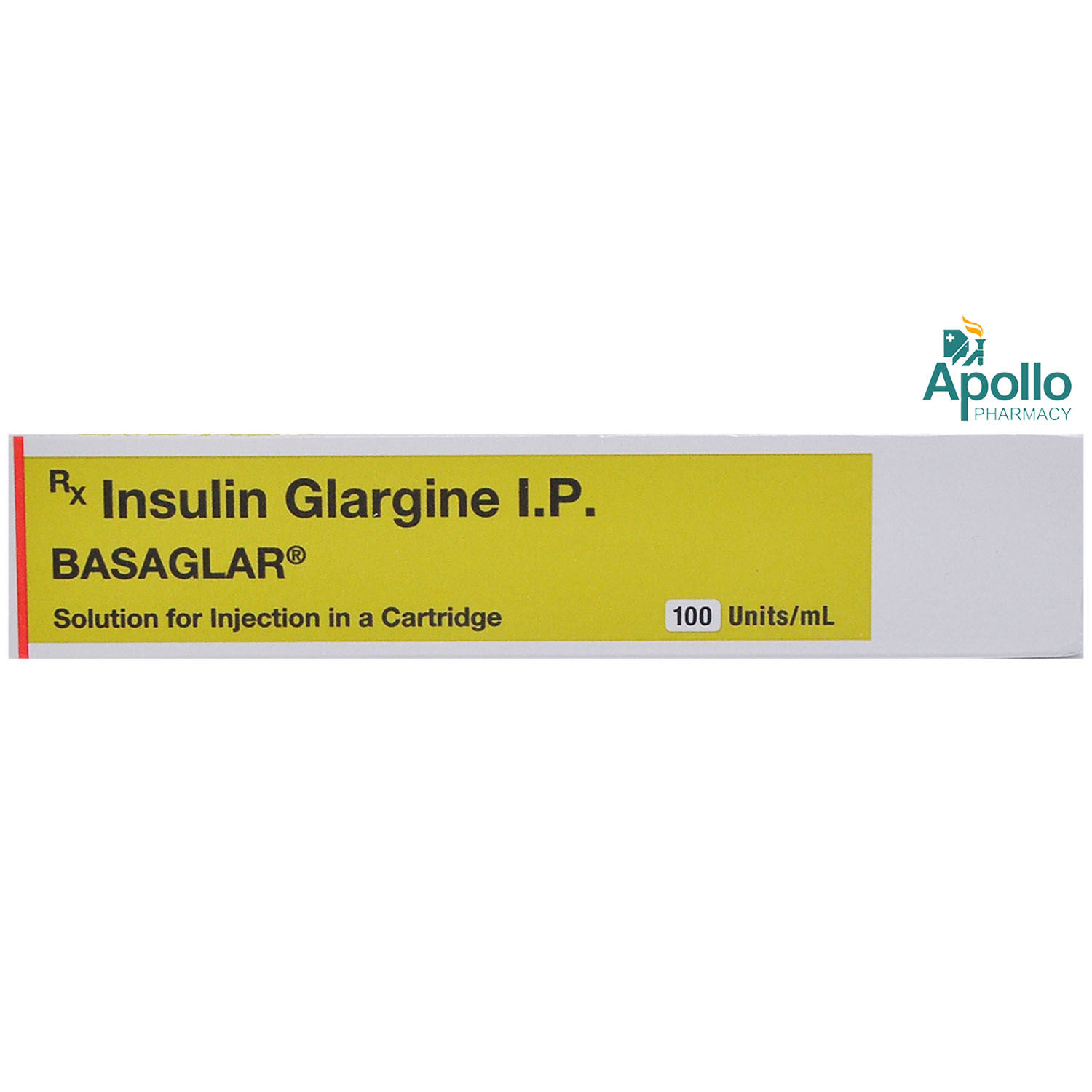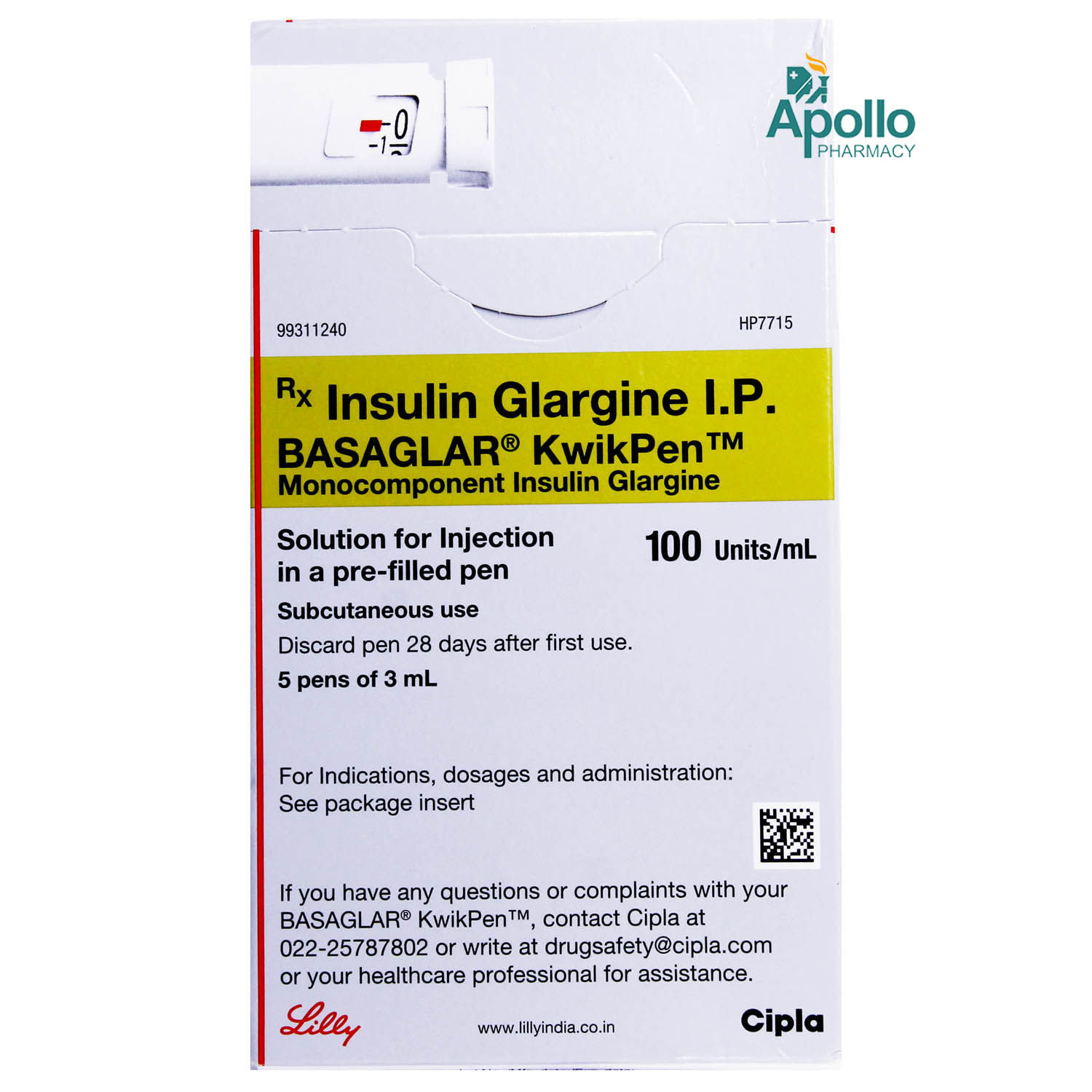Insulin Glargine
About Insulin Glargine
Insulin Glargine is used to treat type 1 diabetes in adults and children and type 2 diabetes mellitus in adults. Diabetes mellitus is a condition in which your body does not produce enough insulin to control blood sugar levels.
Insulin Glargine contains Insulin glargine, which works by replacing the insulin that is normally produced by the body. It also stops the liver from producing more sugar. Thereby, it helps treat type 1 and type 2 diabetes.
Sometimes, Insulin Glargine may cause side effects like injection site reactions, low blood sugar, swelling, and weight gain. Most of these side effects of Insulin Glargine do not require medical attention and gradually resolve over time. However, if the side effects are persistent, reach out to your doctor.
Do not use Insulin Glargine if you are allergic to any of its components. Consult your doctor if you are pregnant or breastfeeding. Keep the doctor informed about your medical conditions and medications to prevent any interactions.
Uses of Insulin Glargine
• Manage diabetes: Insulin Glargine helps in managing both type 1 diabetes (adults and children) and type 2 diabetes (adults).
• Blood sugar level control: Insulin Glargine controls blood sugar levels with a steady insulin release that replicates the body's natural insulin production.
• Long-acting Insulin Therapy: Insulin Glargine provides steady insulin coverage for 24 hours, offering consistent blood sugar control without peaks and dips.
• Reduction of Hyperglycemia: Insulin Glargine is involved in lowering high blood sugar levels, which helps in reducing the risk of diabetes complications like kidney damage and nerve damage.
Medicinal Benefits
- Insulin Glargine contains Insulin Glargine, a long-acting insulin used to improve glycemic control in adults and pediatric patients with type 1 diabetes mellitus and in adults with type 2 diabetes mellitus.
- It provides long-term blood sugar control by maintaining stable blood glucose levels throughout the day and night, reducing the risk of blood sugar spikes and drops.
- Insulin glargine is a man-made form of human insulin which helps replace the insulin that is normally produced by the body and moves sugar from the blood into other body tissues where it is used for energy. It also stops the liver from producing more sugar.
- By maintaining consistent insulin levels, Insulin Glargine helps prevent diabetes-related complications such as nerve damage, kidney problems, and eye disease.
- Its long-acting formula provides a steady effect for up to 24 hours or more with a single daily injection, improving treatment adherence.
Directions for Use
- Follow your doctor's instructions on the dosage and timing of this medication.
- Check the label for directions and use it as advised by the doctor. Choose an injection site such as the thigh, upper arm, or abdomen, pinch the skin and inject the advised dose at a 45-degree angle slowly and steadily.
- Rotate the injection site every time. Do not inject into skin that is red, bruised, or hard. Do not reuse or share needles.
Storage
Side Effects of Insulin Glargine
- Low blood sugar
- Injection site reactions (redness, itching, inflammation)
- Swelling
- Weight gain
Drug Warnings
- Do not use Insulin Glargine if you are allergic to any of its components or if you have diabetic ketoacidosis.
- Inform your doctor if you have liver, kidney or heart problems, nerve damage, low levels of potassium, heart failure or vision problems.
- Consult your doctor if you are pregnant, think you may be pregnant, are planning for pregnancy, or are breastfeeding.
- Avoid driving or operating machinery until you know how Insulin Glargine affects you.
- Insulin Glargine may cause low blood sugar (hypoglycemia). Symptoms include intense hunger, dizziness, irritability, shakiness, or sweating. To quickly manage hypoglycemia, consume fast-acting sources of sugar like fruit juice, non-diet soda, hard candy, raisins, or crackers.
- Insulin Glargine helps control diabetes but does not cure it. Continue using it even if you feel well. Do not stop using Insulin Glargine without talking to your doctor.
- Never reuse needles or syringes. Rotate the injection site each time.
Drug Interactions
Drug-Drug Interactions: Insulin Glargine may have an interaction with other antidiabetic pills (sitagliptin), blood sugar enhancers (diazoxide), blood pressure-lowering pills (metoprolol, clonidine), antidepressants (lithium, fluoxetine), pain killers (aspirin, pentoxifylline, propoxyphene), anti TB drug (isoniazid), growth hormone (somatropin), thyroid hormone-related drugs (levothyroxine), antipsychotic medicines (phenothiazine, clozapine, olanzapine), anti-cholesterol drugs (fenofibrate), anti-asthmatic (epinephrine, salbutamol, terbutaline), female hormones like oestrogens and progestogens.
Drug-Food Interactions: No interactions found.
Drug-Disease Interactions: Inform your doctor if you have kidney disease, liver disease, low blood sugar/glucose level (hypoglycaemia), and low potassium level (hypokalaemia).
Drug-Drug Interactions Checker List:
Safety Advice

Alcohol
unsafeYou are recommended not to consume alcohol along with Insulin Glargine to avoid unpleasant side effects.

Pregnancy
safe if prescribedInsulin Glargine can be used during pregnancy. Your insulin dose may need to be changed during pregnancy and after delivery. Please consult your doctor before taking Insulin Glargine.

Breast Feeding
safe if prescribedInsulin Glargine can be given safely to nursing mothers but only under the supervision of a physician. Your physician may make adjustments in your insulin doses and your diet.

Driving
cautionDrive with caution, Insulin Glargine usually causes drowsiness and affects driving ability. Your ability to concentrate and react may be reduced if you have hypoglycaemia (low blood sugar).

Liver
cautionInsulin Glargine to be taken with caution, especially if you have a history of liver diseases/conditions. The dose may have to be adjusted by your doctor.

Kidney
cautionInsulin Glargine to be taken with caution, especially if you have a history of kidney diseases/conditions. The dose may have to be adjusted by your doctor.

Children
safe if prescribedInsulin Glargine can be given safely to children provided the dose is prescribed by a child specialist.
Habit Forming
Diet & Lifestyle Advise
- Include foods rich in healthy carbohydrates and fibre, fruits, whole grains, and vegetables in your diet.
- Try eating food at regular intervals. Do not skip meals. Also, try not to overeat.
- Follow a healthy diet and walk for at least 45 minutes to complement treatment with Insulin Glargine.
- Maintain a healthy weight by exercising regularly.
- Rest properly, and avoid stress by doing meditation or yoga.
Special Advise
- Change (rotate) your injection sites within the area you chose with each dose to reduce your risk of getting lipodystrophy (pitted or thickened skin) and localised cutaneous amyloidosis (skin with lumps) at the injection sites. Do not use the same spot for each injection or injection where the skin is pitted, thickened, lumpy, tender, bruised, scaly, hard, scarred or damaged.
- When travelling across more than two time zones, you should talk to your doctor about adjustments to your insulin schedule.
Patients Concern
Disease/Condition Glossary
Diabetes: Diabetes is a chronic or lifelong disease that prevents the body from utilising insulin properly. Insulin is the hormone that controls sugar levels in the blood. Diabetes is a condition in which blood glucose levels are above normal. It is of two types: type 1 and type 2 diabetes. Type 1 diabetes is a condition in which the pancreas produces little or no insulin. Type 2 diabetes affects the way the body processes sugar. Symptoms of diabetes include lack of energy, tiredness, frequent urination, excess thirst, dry mouth, blurry vision, constant hunger, weight loss, and itchy skin.
FAQs
Insulin Glargine is used to treat type 1 diabetes in adults and children and type 2 diabetes mellitus in adults.
Insulin Glargine works by replacing the insulin that is normally produced by the body. It helps move sugar from the blood into other body tissues where it is used for energy. Insulin Glargine also prevents the liver from producing more sugar.
Insulin Glargine should be stored in a refrigerator (2°C-8°C). Do not freeze.
Type-2 diabetes generally does not affect healthy children and teens, but it may affect children who are obese, which is also known as Childhood Obesity.
Cut back on foods high in sodium, alcohol, fried foods, and high-carb food and drinks like sugary drinks, drinks with added sugar, white rice and starchy vegetables.
Insulin Glargine should not be discontinued without a doctor's consultation as stopping Insulin Glargine may cause severe hypoglycaemia (low blood sugar) and ketoacidosis (buildup of acid in the blood). Consult the doctor if you feel uncomfortable after taking Insulin Glargine.
The injection site should be changed to prevent skin changes like lumps under the skin. Insulin Glargine may not work well if injected into the lumpy area.
Maintain a healthy diet and exercise regularly. Limit sugar intake and avoid smoking & alcohol consumption. Manage stress by doing meditation or yoga.
Hypoglycaemia (low blood sugar) may occur because you inject too much insulin, miss or delay meals, do not eat enough, eat food containing less carbohydrate than normal, drink alcohol, lose carbohydrates due to vomiting or diarrhoea, do more exercise than usual or a different type of physical activity, are recovering from an injury, illness, operation or stress, or are taking/have stopped taking other medicines.
Insulin Glargine contains insulin glargine, a modified insulin which is very similar to human insulin.
Check the label for directions and use Insulin Glargine as advised by the doctor. Talk to the doctor if you have any concerns. Fill the injection with the appropriate dose. Pick the injection site and wipe it with an alcohol swab. Now, pinch up the skin, inject the needle into the skin and then push the plunger in. After injecting the insulin, pull out the needle and dispose of the syringe safely.
Insulin Glargine should be used only as prescribed by the doctor. The doctor will recommend the dose and duration based on your condition.
Using more than the prescribed dose of Insulin Glargine may cause hypoglycaemia (low blood sugar). Monitor blood glucose levels and consult the doctor if the blood sugar levels are low.
The dose of Insulin Glargine may need to be changed based on your blood sugar levels, lifestyle conditions, if are taking certain other medicines, during pregnancy, after giving birth, and breastfeeding.
Serious side effects of Insulin Glargine include severe allergic reactions (rash/itching all over the body, severe swelling of skin or mucous membrane, shortness of breath, a fall in blood pressure with rapid heartbeat and sweating) and hypoglycaemia (thirst, tiredness, increased urge to urinate, tiredness, fast heartbeat, and low blood pressure). Seek immediate medical attention if you experience these symptoms.
Insulin Glargine can be given to treat both the conditions of type 1 and type 2 diabetes mellitus. However, your doctor will decide whether Insulin Glargine can be given to you or not, depending on your present condition. Insulin Glargine should be avoided in patients who are allergic to Insulin Glargine or other forms of insulin. It should be avoided in patients suffering from low potassium level (hypokalemia), moderate to severe kidney disease or liver disease. Inform the doctor if you are pregnant or breastfeeding.

